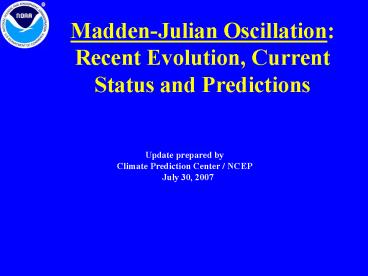MaddenJulian Oscillation: Recent Evolution, Current Status and Predictions - PowerPoint PPT Presentation
1 / 14
Title:
MaddenJulian Oscillation: Recent Evolution, Current Status and Predictions
Description:
The latest observations indicate that the MJO has weakened. ... An additional noteworthy change has been the development of wet conditions ... – PowerPoint PPT presentation
Number of Views:94
Avg rating:3.0/5.0
Title: MaddenJulian Oscillation: Recent Evolution, Current Status and Predictions
1
Madden-Julian Oscillation Recent Evolution,
Current Status and Predictions
Update prepared by Climate Prediction Center /
NCEP July 30, 2007
2
Outline
- Overview
- Recent Evolution and Current Conditions
- Madden-Julian Oscillation Forecast
- Summary
3
Overview
- The latest observations indicate that the MJO has
weakened. - During the past week, enhanced convection has
been focused across the Maritime continent while
dry conditions have been evident in the western
Pacific Ocean east of China. - An additional noteworthy change has been the
development of wet conditions across western
Africa. - Based on the latest monitoring and forecast
tools, weak MJO activity is expected during the
next 1-2 weeks.
4
850-hPa Vector Wind Anomalies (m s-1)
Note that shading denotes the magnitude of the
anomalous wind vectors
Westerly anomalies have weakened across the
east-central Pacific Ocean.
Easterly anomalies have increased in coverage to
include areas from India to the west Pacific
Ocean.
5
850-hPa Zonal Wind Anomalies (m s-1)
Westerly anomalies (orange/red shading) represent
anomalous west-to-east flow. Easterly anomalies
(blue shading) represent anomalous east-to-west
flow.
Westerly anomalies were evident across sections
of the Maritime continent and the western Pacific
Ocean from the latter half of June into mid-July.
Time
Easterly anomalies increased during mid-July over
the Maritime continent and western Pacific and
have shifted eastward during mid-late July.
Winds across much of the eastern Pacific Ocean
have returned to near average.
Longitude
6
Outgoing Longwave Radiation (OLR) Anomalies
(7.5S-7.5N)
Drier-than-normal conditions, positive OLR
anomalies (yellow/orange shading)
Wetter-than-normal conditions, negative OLR
anomalies (blue shading)
Intermittent periods of enhanced convection were
evident in the western Pacific Ocean from late
March into May.
Time
Beginning in mid May, weak-moderate MJO activity
has been observed as regions of suppressed and
enhanced convection have shifted eastward from
the Indian Ocean into the far western Pacific.
Most recently, enhanced convection has shifted
east from the Indian Ocean across the Maritime
continent.
Longitude
7
OLR Anomalies Last 30 days
Drier-than-normal conditions, positive OLR
anomalies (/red shading) Wetter-than-normal
conditions, negative OLR anomalies (blue shading)
30 JUN
During early July, wet conditions stretched from
India into the far western Pacific Ocean with dry
conditions across the eastern Indian Ocean.
Wet conditions developed in the Indian Ocean
during mid-July Enhanced (suppressed)
convection shifted northeastwards in the eastern
Hemisphere. Wet conditions are now evident across
the Maritime continent with dry conditions across
the Philippines.
8
200-hPa Velocity Potential Anomalies (5S-5N)
Positive anomalies (brown shading) indicate
unfavorable conditions for precipitation.
Negative anomalies (green shading) indicate
favorable conditions for precipitation.
Weak to moderate MJO activity was observed during
late February and early March as velocity
potential anomalies shifted eastward.
The MJO was weak or incoherent from mid-March to
mid-May.
Time
Since mid-May, weak to moderate MJO activity has
been observed. The MJO has strengthened during
late July has velocity potential anomalies have
increased and shifted eastward.
Longitude
9
200-hPa Vector Wind Anomalies (m s-1)
Note that shading denotes the magnitude of the
anomalous wind vectors
Westerly anomalies have shifted eastwards during
the last five days.
10
Weekly Heat Content Evolution in the Equatorial
Pacific
During this period two eastward-propagating
Kelvin waves (warm phases indicated by dashed
lines) have caused considerable month-to-month
variability in the upper-ocean heat content.
Time
Since January, negative heat content anomalies
are evident across the eastern equatorial Pacific
and since late March larger positive anomalies
are evident in the far western Pacific Ocean.
A weak Kelvin wave developed in mid-May and
propagated eastwards and reached the eastern
Pacific in early July.
Longitude
11
MJO Index
The current state of the MJO as determined by an
index based on Empirical Orthogonal Function
(EOF) analysis using combined fields of
near-equatorially-averaged 850-hPa and 200-hPa
zonal wind and outgoing longwave radiation (OLR)
(Wheeler and Hendon, 2004). The axes represent
the time series of the two leading modes of
variability and are used to measure the amplitude
while the triangular areas indicate the phase or
location of the enhanced phase of the MJO. The
farther away from the center of the circle the
stronger the MJO. Different color lines indicate
different months.
The MJO index indicates that the MJO signal has
weakened rapidly during the past week.
12
MJO OLR Forecast
The statistical method forecasts little if any
MJO activity during the next 5-10 days.
13
(a)
200850 hPa Vertical Wind Shear
All plots Shading denotes magnitude of vectors
Plots (a),(c),(d) low shear (red), high shear
(yellow/white) Plot (b) Shear greater than
average (blue) Shear less than average
(yellow/red)
(b)
(c)
The GFS forecast indicates low shear across the
west Pacific Ocean during the next 10 days.
(d)
14
NOTICE OF CHANGE
The slides depicting potential benefits and
hazards normally located here will no longer be
placed within the MJO weekly update. Expected
impacts during the upcoming 1-2 week time period
can now be found as part of a new
product Experimental Global Tropics
Benefits/Hazards Assessment The product can be
found at http//www.cpc.ncep.noaa.gov/products/pr
ecip/CWlink/ghazards/ghaz.shtml Please send
questions/comments/suggestions to Jon.Gottschalck_at_
noaa.gov































